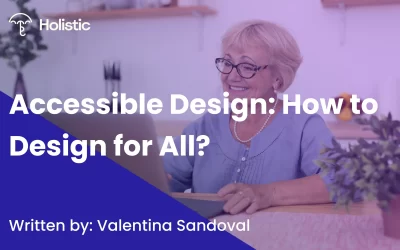We have to recognise that as human beings we sometimes seek to maintain our comfort zone, that we prefer simple tasks and, in general, that we get excited when we manage to carry out a task. This reflects the need to embrace usability in the design process because of its relationship to human behaviour and because usability is an essential component of user experience design.
Usability – A Brief Definition
Although the term has gone through several variations over time and with the perspective of different authors, the most recognised definition today corresponds to that of ISO 9241-210: “the extent to which specific users can use a system, product or service to achieve specific objectives effectively, efficiently and with satisfaction in a specific context of use”.
With this definition in mind we can now familiarise ourselves with some points, tips and considerations for designing with usability in mind and for carrying out tests that lead us to improve our designs.
Designing with usability in mind
Proposing to the user’s needs found in the information gathering as the main axis will facilitate the agility of the project, so from the beginning, it is feasible to generate solutions with usability in mind. For this we can base ourselves on Jakob Nielsen’s well-known usability principles; however, we can implement some other rules that are integrated with both interaction and visual communication; some of them are:
The three-click rule: Maintain easy access to content with short, clear and efficient interactions.
The two-second rule: Avoid making the user wait for more than 2 seconds without sharing information about what is happening.
Care to the last detail (Dieter Rams’ principle of good design): leave nothing to chance, care and precision represent respect for the user.
The odd-numbered rule: it is easier for the user to focus their attention or be more interested in content with an odd-numbered composition.
It is common to find ourselves in scenarios where the predominant objective is to break schemes and innovate, however, we must be careful not to cause ruptures in the user experience.
In this way, it is necessary to recognise that there are ways of interacting that have become recurrent among users; these are interaction patterns that are already used with great skill and therefore sometimes it is better not to change them.
Let us remember that when we design we are proposing possible actions to be carried out with the visual resources that we implement and how we arrange them in a space; it is in our hands that the user can easily identify what he/she can do with these resources.
Affordances in the field of design
Achieving this objective is possible with the implementation of affordances, given that they provide precisely those opportunities for user intervention according to their physical and mental capacities; in the case of interfaces, patterns are one of the most effective affordances for favouring the relationship between the user and the product, accompanied by cognitive and explicit ones, among others.
When talking about patterns, it is necessary to bear in mind that their consolidation can occur thanks to the recurrence in the reaffirmation of mental models.
As these are an internal representation of the appearance and functioning of a product, they influence the actions that users will perform when interacting with the product.
The affordances in interaction design
These models are generated in the user’s mind from their experiences with similar applications, and thanks to them the interpretation of the interfaces we design is facilitated.
By implementing affordances according to the user’s context and conditions, and by keeping the user’s mental models in mind, we achieve a more familiar and cognitively efficient interaction. Maintaining interaction patterns can lead us to be creative with other elements such as icons, colours, typographies and even texts to keep the design aligned with the user’s mental models.
As is well known, the design process is iterative, so a design proposal is constantly evolving. To keep this evolution in line with the user’s needs, it is advisable to carry out some usability tests in which the design team and the development area should be involved so that the user’s needs and the proposal’s shortcomings can be evident to all.
These tests consist of evaluating the usability (among other variables) of a design with a group of users who must have the profile of the User Persona of the project. This includes observing them as they try to achieve a series of tasks that have been specifically designed for the test.
The advantage of these tests lies in the opportunity to improve the user experience by optimising what did not work at the beginning; with them, in addition to validating design ideas, you can prevent the risks of investing time and money in items that are not in line with what the user needs. Let’s look at 3 steps to carry them out:
Planning is the key
It is necessary to establish what the objective of the study is to address the problems more effectively. To do this, specific objectives related to the design solutions to be tested are set out, i.e. objectives around the tasks that the user must achieve and for each of them it is necessary to identify the goals, measures, measurement instruments and metrics to be implemented.
In some cases, having a baseline and the target level for each metric can generate good insights for the analysis of results.
Prepare a script
Having a script for the test will build confidence for both the team and the user, and can ensure that everything you set out to analyse in the planning phase is covered. This can contain user consent, the introduction of the team, context about the team’s work, the importance of the test to the business, asking the user questions about their expectations of the product, and the openness to carry out the test.
The user should know what their goals will be, so describe what tasks they will accomplish during the test, and since the goal is to observe their interactions, prepare an environment where their screen can be visualised and recorded, and ask them to “think out loud” to gain insights into their mental model.
Unravelling the mysteries
During the test, the team has been observing and taking note of what the user is doing and once the test has been completed it is time to analyse the results. At this point, it is worth remembering the objectives of the study in the first instance as it will make it easier to focus on identifying specific issues.
Then the review of the notes will lead to the writing of insights and conclusions that must be transformed into actions to be taken to improve the proposal.
In this phase, it is key to keep in mind the measures and metrics established for each task. Other systems can also be implemented for data collection such as the QUIS (Questionnaire for User Interface Satisfaction), System Usability Scale (SUS) or the Usefulness, Satisfaction, and Ease of Use (USE) questionnaires. The selection of these tools and questions should be done in the planning step.
Conclusion
There are many doubts that design teams have while proposing a solution and it is essential that in addition to user needs and business requirements, we rely on principles, guidelines or rules to integrate usability thinking from the beginning of the ideation process.
Additionally, usability testing allows us to detect problems of interpretation, use and interaction to improve them.
REFERENCES
Ambrose, G., & Salmond, M. (2014). Designing for the audience: Usability in design. In The fundamentals of interactive design.
Hartson, R., & Pyla, P. (2012). The UX Book: Process and Guidelines for Ensuring a Quality User Experience.
Hernandez Leonardo (2018). Design a conceptual model that combines different mental models.
https://medium.com/@leonardo.hernandez/dise%C3%B1a-un-modelo-conceptual-que-combine-con-diferentes-modelos-mentales-7401cce8b82e
ISO 9241-210:2019(en) Ergonomics of human-system interaction – Part 210: Human-centred design for interactive systems.
https://www.iso.org/obp/ui/#iso:std:iso:9241:-210:ed-2:v1:en
Interactive design foundation – Affordances
https://www.interaction-design.org/literature/topics/affordances
Interactive design foundation – Usability
https://www.interaction-design.org/literature/topics/usability
Usability Testing: Tricking Gov into Working for People – Dana Chisnell, Center for Civic Design
https://open.spotify.com/episode/6EkZhXbgqW8fUYxMhWPWGH?si=H2-3G38RQkuD34N7FLeEQg&utm_source=whatsapp&dl_branch=1
10 usability principles for user interface design
https://medium.com/@alanmartinez/10-usability-principles-for-user-interface-design-f35d9d01643f




